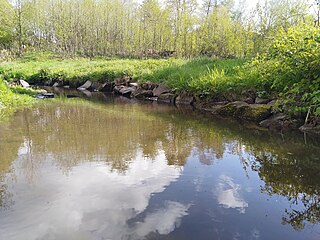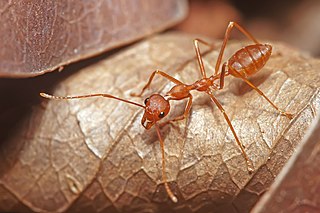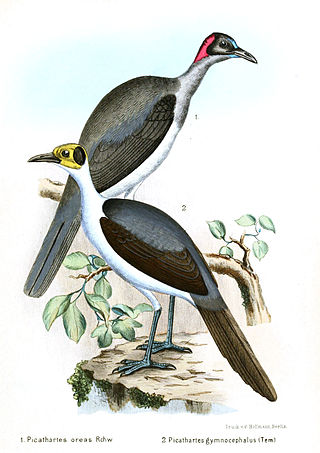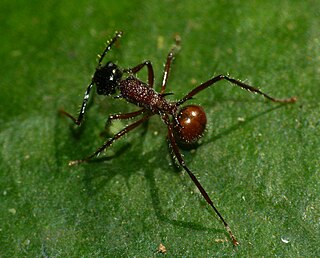
Ants are eusocial insects of the family Formicidae and, along with the related wasps and bees, belong to the order Hymenoptera. Ants evolved from vespoid wasp ancestors in the Cretaceous period. More than 13,800 of an estimated total of 22,000 species have been classified. They are easily identified by their geniculate (elbowed) antennae and the distinctive node-like structure that forms their slender waists.

A nest is a structure built for certain animals to hold eggs or young. Although nests are most closely associated with birds, members of all classes of vertebrates and some invertebrates construct nests. They may be composed of organic material such as twigs, grass, and leaves, or may be a simple depression in the ground, or a hole in a rock, tree, or building. Human-made materials, such as string, plastic, cloth, or paper, may also be used. Nests can be found in all types of habitat.

The leatherback sea turtle, sometimes called the lute turtle, leathery turtle or simply the luth, is the largest of all living turtles and the heaviest non-crocodilian reptile, reaching lengths of up to 1.8 metres and weights of 500 kilograms (1,100 lb). It is the only living species in the genus Dermochelys and family Dermochelyidae. It can easily be differentiated from other modern sea turtles by its lack of a bony shell; instead, its carapace is covered by oily flesh and flexible, leather-like skin, for which it is named.
The Mud Islands reserve is located within Port Phillip, about 90 km (56 mi) south-west of Melbourne, Australia, lying 10 km (6.2 mi) inside Port Phillip Heads, 7 km (4.3 mi) north of Portsea and 9 km (5.6 mi) east of Queenscliff. The land area of about 50 hectares is made up of three low-lying islands surrounding a shallow tidal 35-hectare (86-acre) lagoon connected to the sea by three narrow channels. The shapes and configuration of the islands change over the years due to movement of sand by tidal currents.

A body of water or waterbody is any significant accumulation of water on the surface of Earth or another planet. The term most often refers to oceans, seas, and lakes, but it includes smaller pools of water such as ponds, wetlands, or more rarely, puddles. A body of water does not have to be still or contained; rivers, streams, canals, and other geographical features where water moves from one place to another are also considered bodies of water.

The thorny devil, also known commonly as the mountain devil, thorny lizard, thorny dragon, and moloch, is a species of lizard in the family Agamidae. The species is endemic to Australia. It is the sole species in the genus Moloch. It grows up to 21 cm (8.3 in) in total length, with females generally larger than males.

Weaver ants or green ants are eusocial insects of the family Formicidae. Weaver ants live in trees and are known for their unique nest building behaviour where workers construct nests by weaving together leaves using larval silk. Colonies can be extremely large consisting of more than a hundred nests spanning numerous trees and containing more than half a million workers. Like many other ant species, weaver ants prey on small insects and supplement their diet with carbohydrate-rich honeydew excreted by small insects (Hemiptera). Weaver ant workers exhibit a clear bimodal size distribution, with almost no overlap between the size of the minor and major workers. The major workers are approximately 8–10 mm (0.31–0.39 in) in length and the minors approximately half the length of the majors. Major workers forage, defend, maintain, and expand the colony whereas minor workers tend to stay within the nests where they care for the brood and 'milk' scale insects in or close to the nests.

The loggerhead sea turtle is a species of oceanic turtle distributed throughout the world. It is a marine reptile, belonging to the family Cheloniidae. The average loggerhead measures around 90 cm (35 in) in carapace length when fully grown. The adult loggerhead sea turtle weighs approximately 135 kg (298 lb), with the largest specimens weighing in at more than 450 kg (1,000 lb). The skin ranges from yellow to brown in color, and the shell is typically reddish brown. No external differences in sex are seen until the turtle becomes an adult, the most obvious difference being the adult males have thicker tails and shorter plastrons than the females.

Bhitarkanika National Park is a 145 km2 (56 sq mi) large national park in northeast Kendrapara district in Odisha in eastern India. It was designated on 16 September 1998 and obtained the status of a Ramsar site on 19 August 2002. The area is also been designated as the second Ramsar site of the State after the Chilika Lake. It is surrounded by Bhitarkanika Wildlife Sanctuary, which spread over 672 km2 (259 sq mi). Gahirmatha Beach and Marine Sanctuary are to the east, separating the swamp region and mangroves from the Bay of Bengal. The national park and wildlife sanctuary is inundated by the rivers Brahmani, Baitarani, Dhamra, and Pathsala. It hosts many mangrove species, and is the second largest mangrove ecosystem in India.

The New Zealand fairy tern or tara-iti is a subspecies of the fairy tern endemic to New Zealand. It is New Zealand's rarest native breeding bird, with about 40 individuals left in the wild. It nests at four coastal locations between Whangarei and Auckland in the North Island. It is threatened by introduced predators, extreme storms and tides, beach activity, and waterfront development.

The grey-necked rockfowl is a medium-sized bird in the family Picathartidae with a long neck and tail. Also known as the grey-necked picathartes, this passerine is mainly found in rocky areas of close-canopied rainforest from south-west Nigeria through Cameroon, Equatorial Guinea, and south-west Gabon. It additionally lives on the island of Bioko. Its distribution is patchy, with populations often isolated from each other. The rockfowl typically chooses to live near streams and inselbergs in its forested habitat. It has no recognized subspecies, though some believe that it forms a superspecies with the white-necked rockfowl. The grey-necked rockfowl has grey upperparts, a light grey breast, and lemon-coloured underparts. Its unusually long tail is used for balance, and its thighs are muscular. The head is nearly featherless, with the exposed skin being powder blue on the forehead and upper mandible and carmine on the hindcrown. The bird's cheeks and eyes are covered in a large, circular black patch that, though narrow, connects and divides the carmine and powder blue skin at the peak of the crown. Though the bird is usually silent, some calls are known.
The mangroves of the Straits of Malacca are found along the coast of Thailand, Malaysia, Singapore and northern Sumatra. These tropical mangrove forests are highly diverse, and are important wetlands with high conservation values. There are two Ramsar sites along the Strait of Malacca: Pulau Kukup and Tanjung Piai.

Salt pannes and pools are water retaining depressions located within salt and brackish marshes. Pools tend to retain water during the summer months between high tides, whereas pannes generally do not. Salt pannes generally start when a mat of organic debris is deposited upon existing vegetation, killing it. This creates a slight depression in the surrounding vegetation which retains water for varying periods of time. Upon successive cycles of inundation and evaporation the panne develops an increased salinity greater than that of the larger body of water. This increased salinity dictates the type of flora and fauna able to grow within the panne. Salt pools are also secondary formations, though the exact mechanism(s) of formation are not well understood; some have predicted they will increase in size and abundance in the future due to rising sea levels.

A marine habitat is a habitat that supports marine life. Marine life depends in some way on the saltwater that is in the sea. A habitat is an ecological or environmental area inhabited by one or more living species. The marine environment supports many kinds of these habitats.
Colobopsis anderseni, synonym Camponotus anderseni, is a species of mangrove ant found in northern Australia.

Polyrhachis is a genus of formicine ants found in the Old World with over 600 species. The genus is yet to be comprehensively resolved and contains many varied species including nest-weavers, swimming workers, soil and tree-dwellers.

In biology, semiaquatic refers to various macroorganisms that live regularly in both aquatic and terrestrial environments. When referring to animals, the term describes those that actively spend part of their daily time in water, or land animals that have spent at least one life stages in aquatic environments. When referring to plants, the term describes land plants whose roots have adapted well to tolerate regular, prolonged submersion in water, as well as emergent and (occasionally) floating-leaved aquatic plants that are only partially immersed in water.

Thalassina anomala, known as the scorpion mud lobster, is a species of crustacean in the family Thalassinidae.

Te Matuku Marine Reserve is a marine reserve administered by the New Zealand Department of Conservation. It includes Te Matuku Bay, one of the largest and least disturbed estuaries on Waiheke Island, as well as a surrounding area of sea. It covers an area of 690 ha and was established in 2003.















